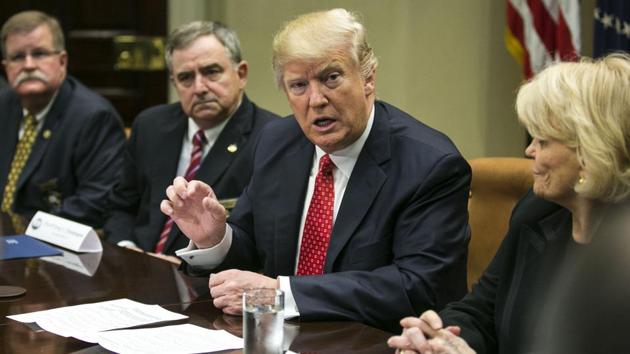H-1B debate reflects a larger change in US party politics
An elected party represents a coalition of social groups. The big switcheroo taking place is the migration of the white working class vote to the Republicans
Immigration, or restriction of the same, is the policy front that may come to define the Donald Trump administration. No US president, Republican or Democrat, has so strongly opposed migration in the postwar era. There may be more to this than just prejudice. Trump’s presidency reflects what is becoming a major realignment of the US political system.

Consider what the Republican ideology has traditionally stood for: Free trade, mass migration and reduced welfare spending. Then look at the candidate the party faithful chose. Trump opposes trade, wants to build walls against migrants, has promised to not reform Social Security and universalise healthcare.
Some argue Trump is not a real Republican. It may be that he reflects the future of the party. As Jeremy Binckes of salon.com wrote, “The next generation of Republicans are going to be Donald Trump Republicans.” More interestingly is the likelihood that much of this free market thinking, minus the welfare cuts, may be the platform of a future Democratic Party coalition.
Read: Trump hasn’t signed any executive order on H1-B visas, India will react if he does: Govt
Why is this happening? An elected party represents a coalition of social groups. The big switcheroo taking place is the migration of the white working class vote to the Republicans. A pillar of Franklin Delano Roosevelt’s New Deal coalition, the 1970s recession drove them into the arms of Ronald Reagan. They went back and forth after that, for example voting for Bill Clinton but rejecting John Kerry. But their Republican links kept getting weaker, especially as the culture wars over gay rights and abortion slowly wound down and only economic and identity issues were left behind. And on these issues these workers were at odds with the corporate Republicans who dictated the party’s legislative agenda.
During last year’s presidential campaign this gap became so large that Trump slipped through. A Pew Research Centre poll showed that among Trump supporters 66% saw immigration as a “very big problem,” on par with terrorism. Only 17% of Hillary Clinton voters thought the same. Trump was the only one who defied free market orthodoxy to turn against it – and against trade, welfare cuts and fiscal prudence.
Read: H1-B visa concerns: IT stocks tumble by 9%; TCS, Wipro, Infosys take a hit
Who will be the US supporters of immigration and, its sister concern, trade in the future? The polling evidence seems to be clear. The younger an American, the more educated, the more metropolitan and the more likely he or she to support open borders.
The backbone of present Democratic support – big city, college-educated whites and minorities – are exactly these groups. “The withering-away of industrial unions, thanks to automation as well as offshoring, will liberate the Democrats to embrace free trade along with mass immigration,” argues Michael Lind of the New America Foundation. A Democrat today is two times more likely as a Republican to believe immigrants are positive. “The Democrats of 2030 may be more pro-market than the Republicans,” says Lind.
But for now, the US will lose the political consensus regarding immigration that it has enjoyed since at least the 1960s. There is some nuance here, however. Polls show Asian and European immigrants receive positive views from all Americans, receiving one-fourth the negative views of Latinos and West Asians.
These sort of divisions exist within the Trump administration. Stephen Bannon, the closest things to a white nativist in the White House, in an interview of Trump complained that so many Silicon Valley chief executives were South Asian. The president-to-be disagreed saying, “I still want people to come in. But I want them go through a process.”
The leaked White House memoranda indicate the likely trajectory of US immigration policy: a barred door for the poor and uneducated, a welcome mat for PhDs and B Techs.
Read: H1-B visa: Silicon Valley frets as team Trump pushes for curbs
However, the slow turn taking place with US immigration policy, combined with the incoherence of the Trump administration, will most likely mean difficulties for immigrants of all varieties for some years to come.
During this time, the real loss for the US could be the loss of immigrant entrepreneurs, the secret sauce of places like Silicon Valley, North Carolina’s Research Triangle and the New Jersey pharma hub. About a third of US hi-tech startups are started by immigrants, thanks to the country’s ability to attract the world’s best brains.
The most telling example of how eager such talent is to stay in the US has been the 1.5 million tech workers, largely Indian and Chinese, who came over on H-1B visas and now queue to convert them into green cards. The wait has slowly increased to several years. Trump’s plans would possibly make the present legal limbo into a permanent purgatory.
Read: H-1B visa bill tabled: It’s difficult to replace Americans with Indian I-T workers
Unsurprisingly, many of this exceptionally well-educated pool of migrants are beginning to look home, especially the Chinese and Indians. Even before Trump’s election this was beginning to show up in the numbers. Vivek Wadhwa, a US-based tech commentator, argues this is why the “proportion of immigrant-founded startups in Silicon Valley fell from 52% in 2005 to 44% in 2012 and is probably even lower now.” In the coming four years it may become a flood. At least until the ongoing political realignment of America throws up a Democratic government which advocates the policies Republicans once held as their own.





